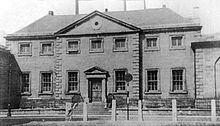Hospital type Specialist Closed 1954 | Speciality Venereal disease Founded 1792 | |
 | ||
Similar Sir Patrick Dun's Hospital, Royal Hospital - Donnybrook, Dr Steevens' Hospital | ||
The Westmoreland Lock Hospital was a hospital for venereal disease originally located at Donnybrook and later moved to Lazar's Hill (now Townsend St.), Dublin, Ireland.
Contents
History
There was a hospital to treat venereal disease in Donnybrook since the middle of the 18th century, but its distance from the city centre made it unattractive for physicians. At the same time the Hospital for Incurables in Townsend St. was running out of space. It was decided to swap locations, which benefited both hospitals.
The new hospital was founded in 1792, when Westmoreland was Lord Lieutenant of Ireland, and was located at the corner of present-day Townsend St. and Luke St., where its foundations were excavated in 1998. It later operated under the name of the Hospital of St. Margaret of Cortona. The 'Lock Hospitals' were developed for the treatment of syphilis following the end of the use of lazar hospitals, as leprosy declined. In the 18th century another Lock Hospital was located in Clarendon St., Dublin.
Initially the hospital treated 300 people of both sexes. This was later reduced to 150 beds and from 1820 only women were admitted (males were sent to Dr Steevens' Hospital and the Richmond Hospital). It was supported by the state from the outset. Catholics and Protestants were segregated. In the 19th century most of the patients were prostitutes, a consequence of the large military presence in the city - Dublin having the "largest garrison of the British army at home or in the colonies" (Under-Secretary Thomas Larcom). It became part of the objectives of the hospital governors to prevent the transmission of venereal disease to troops stationed in the city, and the hospital was provided with a grant from the government to effect this.
In 1794 the Lock penitentiary opened, which catered for women who had been discharged from the hospital. Other destinations for those discharged were the Lying-in hospital (now the Rotunda Hospital), the work-house, or the Cork Street Fever Hospital, Dublin. The hospital never had power to hold women against their will.
In 1945 the hospital was given special responsibilities for co-ordinating the treatment of women and infants in Dublin but was given no additional funding to do so. The hospital soon exhausted its savings. Unlike the other Dublin hospitals, it had no voluntary subscribers. In 1949, the crumbling hospital building was declared unsafe and the hospital was closed shortly afterwards when the building was demolished. The Royal College of Physicians of Ireland holds a comprehensive collection of minutes, patient registers, reports and accounts of the Hospital from its foundation up to the end of the 19th century.
Physicians
At the turn of the 19th century the senior surgeons were doctors Henthorn and M'Evoy, assisted by doctors Lestrange, Dease and Sir Philip Crampton. Some time later Richard Carmichael was surgeon. In the mid-19th century the senior surgeon was Doctor J. Egan. A little later, in 1862, R. H. Emerson and Thomas Byrne were surgeons. In 1868 B. M'Dowell and J. Morgan were surgeons. Dr. William Stokes (1838–1900) was a governor of the hospital.
In 1871 James Wilson Hughes was elected registrar of the hospital (out of a total of 100 applicants). He was well known in Dublin for having saved the lives of seven women at a fire in the Kildare Street Club in November 1860.
In the 20th century doctors George Pugin Meldon and Percy Kirkpatrick spent most of their lives working in the hospital.
Origin of the name
The name dates back to the earlier leprosy hospitals, which came to be known as lock hospitals after the "locks", or rags, which covered the lepers' lesions.
Ballads
A number of broadside ballads were printed in Britain and Ireland in the 19th century referring to the Lock Hospital or a similar institution, and the downfall of a young man or soldier (and later, woman). An early mention of a hospital is on early 19th broadsides, referring to The Lock Hospital established in 1746 at Hyde Park Corner, London. A song was called The Unfortunate Rake in Ireland and was sung in Dublin in the 1790s (there is a Folkways record - "The Unfortunate Rake", FS 3805 - dedicated exclusively to this family). A tune with this name was printed in Crosby's Irish Musical Repository in 1808. In America, the song has been adapted to the cattle range (The Cowboy's Lament or The Streets of Laredo) and the gambling hall (St. James' Infirmary).
Christy Moore recorded the Locke Hospital on "Prosperous" (1972).
